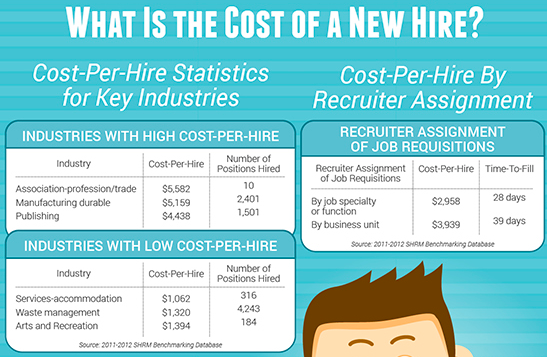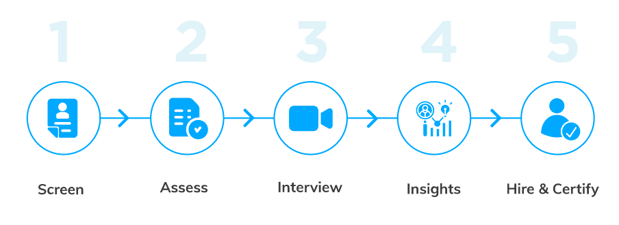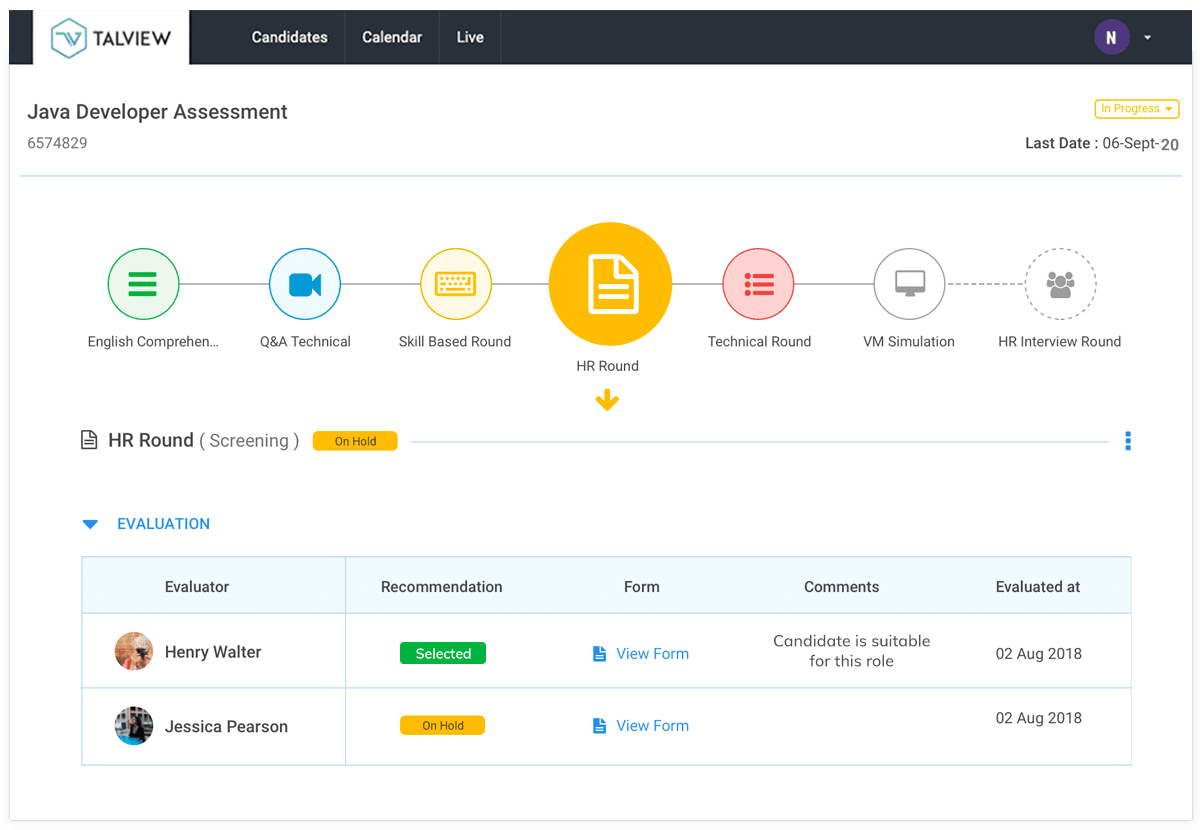In our previous blog post, we explored the three key recruitment metrics that every company should track for a faster and efficient hiring process – time to hire, cost per hire, and quality of hire. We discussed how these three recruitment metrics are the pillars on which every company’s recruitment strategy should be built.
In this blog post, we will deep dive into one of those metrics – cost per hire – and understand why and how one should track it.
We will discuss the metric’s definition, its benefits and importance, the formula to calculate the cost per hire, and ways to reduce it.
What is cost per hire?
Cost per hire refers to an average of all costs associated with filling vacant positions in an organization.
Your average cost per hire can include internal costs such as the recruiter fees/salary, travel expenses, learning and development expenses, to external costs such as advertising, assessment center fees, cost of assessment providers, and more.
The average cost of hiring varies by industry, organization, and region. According to Glassdoor, an average company in the U.S. spends about $4,000 to hire a new employee. The average cost per hire in the UK is also about the same amount.
As per Recruiterbox, the total cost of hiring a new employee could be $5,000 or more in a professional or manufacturing industry while hiring a new employee in a services-related industry typically costs a bit more than $1,000.

Source: Recruiterbox
Why is it important to track the ‘cost per hire’ metric?
Understanding why and how your organizations and teams are spending their allocated budget is essential.
For the recruiting team, the entire budget is utilized for hiring-related processes. These costs could be a result of things such as the number of new hires, staff turnover, cost of onboarding new employees, collecting a group of recruiters for campus recruitment, taking care of their travel and stay during campus season, buying pre-hire assessments, et al.
Knowing the cost of each step of the recruitment process helps quantify your hiring efforts. It can help you understand where the money is being used, where it is being used ineffectively, and where it can be saved.
It helps you determine where to focus your efforts and understand the efficacy of your recruitment process.
Not just that, you can also improve your time to hire significantly by focusing on areas of improvement in the hiring process and cutting down on steps that are unnecessary.
How can you calculate your organization's ‘cost per hire’?
Use this simple cost per hire formula for your organization:
| (The total internal recruiting costs + external recruiting costs) / (total number of hires in a given time frame) |
As discussed before, the total average cost of hiring an employee in any organization is an amalgamation of multiple factors that must be calculated correctly. These factors can be clubbed into two broad categories as follows:
- Internal factors: These factors are the expenses within the organization for the hiring process involving internal staff. This may include the recruiter’s fees, hiring software cost, screening and background check software, travel expenses, referral bonuses, etc.
- External factors: These are the expenses of anything outside the organization related to the recruitment process, from external staffing vendors to candidate-related expenses. Some examples include advertisements, external recruiter expenses, assessment center fees, assessment providers’ fees, candidate relocation and travel, etc.
These external and internal factors are some of the visible costs of hiring a new employee. But there are other factors or opportunities that are not too obvious that can add up to this list, if not monitored or rectified.
One of them is the opportunity cost of an unfilled position. The longer a position goes unfilled, the more overworked the other teammates can get, lowering their motivation and, eventually, their productivity.
Another big factor that can become a budget drain on organizations is the time to hire. The duration of your hiring process can directly affect the amount of money you end up spending while hiring someone.
While sometimes reducing your average time to hire can seem difficult, given budget constraints and talent shortages, a shorter time to hire is not unachievable.
A hiring lag not only affects the revenue and profits of the team, but also the team’s productivity levels, turnover rate, candidate experience, and more. Read this blog post to know the 9 big costs of a hiring lag with formulas to calculate them.
How can you reduce your ‘cost per hire’?
Now that you know all the aspects that lead to a higher cost of hiring, let us explore some of the ways in which you can reduce the recruiting costs in your organization and, at the same time, optimize your hiring process.
1. Employing Recruitment Technology
Implementing recruitment automation technology in your hiring process will help. Recruiting software can practically automate almost every step in the hiring process. Some modern HR technology tools and software are equipped to carry out the entire end-to-end hiring process on its own with minimal human guidance.
This way, you can screen, assess, interview, and hire new candidates without going through the hassles of coordinating, scheduling, reminding, following up, and interviewing.
These things impact recruiter productivity which could be spent building relationships with the best-matched candidates and could lead to better hires. And the more time it takes for you to hire, the higher the cost of hiring goes.
Recruitment automation tools can help you move your pen and paper tests online by letting you feed in your assessment questions and their answers in the platform or your ATS. Once done, you share the assessment with multiple candidates in just one go and get their responses all in one place.
This helps streamline the entire assessment process and enables the recruiter to keep a track of each candidate individually. Streamlining and standardizing the assessment process helps teams to reduce expenditure on steps or tasks that are redundant.

Talview’s end-to-end recruitment platform
For instance, Talview’s end-to-end hiring platform helps you do just that. With its AI-powered capabilities, the platform lets you conduct almost all recruitment-related processes while significantly bringing down your cost per hire.
Read how one of our customers was able to save about $840k in operational costs by simply automating their campus hiring process.
2. Automating Mundane Tasks
Recruiters spend a large portion of their time performing certain small, but important steps while hiring, such as sending invitations to multiple candidates, sending reminder notifications, tracking and following up, etc.
These tasks might appear to be small but end up taking up a lot of time and effort of recruiters, especially if a recruiter is hiring for a high-volume role like software developer, sales executive, or customer service.
Automated workflows help automate these tasks and save you time and resources.
Recruiters can create elaborate recruitment workflows that help them automate the entire hiring process with zero to minimal human intervention: inviting candidate applications through a recruitment chatbot, sending them nurture and follow-up emails, and providing them online assessments and video interviews as they qualify.
 A configurable workflow created with Talview hiring software to hire a Java Developer
A configurable workflow created with Talview hiring software to hire a Java Developer
Under an automated workflow, you can manage the process with minimal intervention through each round. This eases the process considerably as technology supports your interactions with candidates versus being the sole point of contact for a candidate.
Recruiters do not have to constantly keep up with every candidate and ensure they all are also being nurtured. Since routine tasks are automated, this helps bring down the cost per hire significantly.
3. Reusing Candidate Data
The longer you take to fill a position, the higher the cost goes. Glassdoor estimates that unfilled jobs in the US tech market alone add up to a value of $20.1 billion. Forbes wrote about the various costs of unfilled positions, apart from the direct loss of money, in the tech industry.
While a regular ATS can also save candidate profiles for later use, it does not actively help you source suitable candidate profile(s) when needed for future roles.
But through Machine Learning, it is possible to not just store candidate data, but also reuse it effectively. All the candidates who do not qualify for a particular role at a particular time could, over time, build a talent pool for you anytime you need to hire quickly for a position.
You will save money on advertisements, outsourced recruiters, job portals, and more.
Tools such as Talview work on this framework where all the unhired candidate profiles are stored away for later reference. Whenever there is a requirement for a similar profile, it pushes a trigger for a match, saving the time it takes to look for new talent, and eventually, saving the cost of a position remaining unfilled.
Conclusion
To have an analytical and data-driven hiring strategy, you must understand your cost per hire. It is an excellent source of information to help employers gauge their hiring efforts. While the cost per hire might differ in different industries or countries, knowing it helps the recruiting team take better and informed hiring decisions.
In addition to the cost of hire, read our previous blog post about the three key recruitment metrics.







Leave a Reply